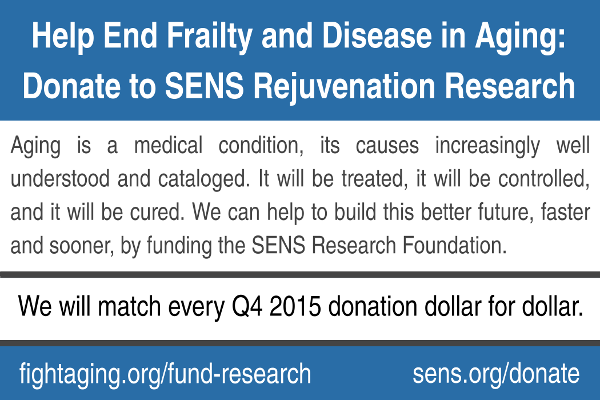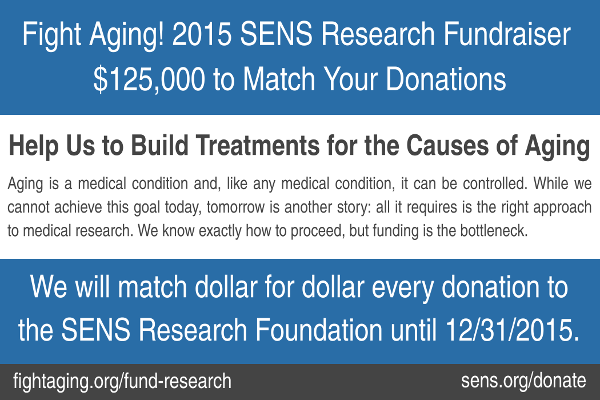The Aging Chart Resource
Here I'll point out the Aging Chart site, a new resource on aging and longevity research assembled by a group of largely Russian researchers. Over the past decade, the Russian-language side of the longevity science community, especially the folk associated with the Science for Life Extension Foundation, has produced all sorts of publicity and explanatory materials aimed at both laypeople and researchers. These range from glossy advocacy for development of effective treatment of aging to quite detailed visualizations of portions of the known molecular biology of aging and roadmaps for the future of rejuvenation research. The people involved here have always demonstrated a good sense of the need for advocacy and public support to bring lasting life to research efforts.
Collectively, the Russian aging research community has a vision that overlaps somewhat with that of the SENS Research Foundation in technical details, but is in general far more focused on tinkering with the operation of metabolism and epigenetic alterations than I would agree is the best path forward. In that it is perhaps closer to the Hallmarks of Aging opinions on how to classify the mechanisms of aging and thereby approach its treatment. You can see this at the detail level if you take a look at Alexey Moskalev's blog. You'll find a lot of the original Russian visualizations there, but sadly very few of them had been translated into English and made available until recently. Thanks to a closer collaboration between the English-language and Russian-language research communities in recent years, and a growing number of fluently bilingual researchers, more of these resources are becoming available to peruse in English.
Aging Chart is a collection of community-curated pathways and knowledge related to aging. Aging Chart makes its debut stocked with 114 pathways, networks, and concept maps on all topics related to aging, from gene-centered pathways to those describing aging processes, age-related diseases, longevity factors, and anti-aging strategies. Contributions are openly encouraged. The pathway diagrams are interactive, with clickable nodes for user-led exploration that link to related pages and pathways for any particular element of interest.
Aging Chart: a community resource for rapid exploratory pathway analysis of age-related processes
As the world population is rapidly aging, the prevalence of aging-related diseases and the demand for expensive, long term health care is also rising. To offset the burden of this shift, scientific knowledge and innovation will become increasingly crucial, and anti-aging and disease prevention strategies will become national and international priorities. Aging research as a field will boom. Nevertheless, it faces several challenges, and the growth will need direction. One of the challenges is the current lack of a freely available, comprehensive collection of aging-related biological pathways and encyclopedia of aging knowledge. Biological pathways are one of the most powerful visualization tools in biology. They provide an intuitive, systems view of the interactions between the multitude of individual elements in any given process. They can be interactive for user-directed exploration and amenable to computational methods, and they are indispensable in making sense of large-scale data sets, where a multitude of individual changes may reflect a small number of more biologically important (and more statistically powerful) changes at the pathway level. Pathway collections are a key feature of many biological data repositories in the public domain.The lack of an aging pathway collection until now may reflect the fledgling nature of the field but also stems in part from the sheer diversity of aging-related processes. Characterizing these is a monumental task. Aging itself is a complex process that occurs at all levels in all systems of the body, leads to a loss of function and triggers a number of diseases. There is ongoing debate as to whether aging is itself a treatable disease. As such, aging research involves a highly diverse community of researchers with various perspectives. If any single narrative of aging mechanisms is to be constructed, the community needs a platform where knowledge can be pieced together collaboratively into pathways, node by node, and ultimately into a unified theory. There have been many previous attempts at structuring aging data and knowledge on the web, but there is still a need for a rapid, intuitive, visual overview of aging processes, from environmental triggers down to molecular interactions. To our knowledge, no such resource yet exists. To fill this gap, we have developed Aging Chart, a wiki-based, community-curated biological pathway collection and encyclopedia of aging processes. Aging Chart will complement and add to the existing set of public aging-related data- and knowledge bases on the web.

